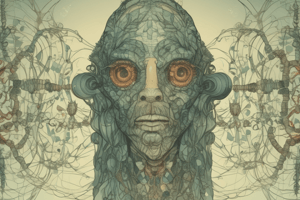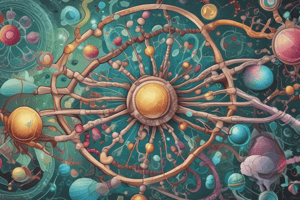Podcast
Questions and Answers
Proteins are required for the ______, ______, and ______ of body tissues and organs.
Proteins are required for the ______, ______, and ______ of body tissues and organs.
structure, function, regulation
Epigenetic changes are entirely determined by genetics and cannot be influenced by environmental factors.
Epigenetic changes are entirely determined by genetics and cannot be influenced by environmental factors.
False (B)
Which of the following is NOT a characteristic of the epigenome?
Which of the following is NOT a characteristic of the epigenome?
- Changes with age and follows an epigenetic clock.
- Can be transmitted to future generations.
- Provides a research base for understanding environmental triggers of disorders.
- Determines the sequence of DNA nucleotides. (correct)
- Controls gene expression by altering chemicals around DNA.
Which of the following is NOT a characteristic of mitosis?
Which of the following is NOT a characteristic of mitosis?
Explain the concept of 'evocative' heredity-environment correlation, providing an example.
Explain the concept of 'evocative' heredity-environment correlation, providing an example.
A recessive gene will be expressed only if it is paired with another recessive gene for the same trait.
A recessive gene will be expressed only if it is paired with another recessive gene for the same trait.
Match the following heredity-environment correlation types with their descriptions:
Match the following heredity-environment correlation types with their descriptions:
What is the name of the specialized cell division process responsible for the formation of human sex cells (gametes)?
What is the name of the specialized cell division process responsible for the formation of human sex cells (gametes)?
The combination of 23 chromosomes from the ovum and 23 chromosomes from the sperm cell forms a ______, a single cell with 46 chromosomes.
The combination of 23 chromosomes from the ovum and 23 chromosomes from the sperm cell forms a ______, a single cell with 46 chromosomes.
Which of the following is an example of a recessive genetic disorder?
Which of the following is an example of a recessive genetic disorder?
Match the following genetic terms with their corresponding definitions:
Match the following genetic terms with their corresponding definitions:
Mutations in genes can only occur during meiosis, the process of sex cell formation.
Mutations in genes can only occur during meiosis, the process of sex cell formation.
What is the primary function of proteins within the human body?
What is the primary function of proteins within the human body?
Flashcards
Genes
Genes
Units of hereditary information composed of DNA that help cells reproduce and produce proteins.
Mitosis
Mitosis
A process where body cells duplicate themselves to grow and repair tissues, creating exact replicas.
Meiosis
Meiosis
The process of cellular division that produces gametes (sex cells) with half the number of chromosomes.
Zygote
Zygote
Signup and view all the flashcards
Alleles
Alleles
Signup and view all the flashcards
Dominant Gene
Dominant Gene
Signup and view all the flashcards
Recessive Gene
Recessive Gene
Signup and view all the flashcards
X-linked Inheritance
X-linked Inheritance
Signup and view all the flashcards
Proteins
Proteins
Signup and view all the flashcards
Epigenome
Epigenome
Signup and view all the flashcards
Epigenetic marks
Epigenetic marks
Signup and view all the flashcards
Heredity-Environment Correlation
Heredity-Environment Correlation
Signup and view all the flashcards
Passive correlation
Passive correlation
Signup and view all the flashcards
Study Notes
Genes
- Human life begins as a single cell
- Each cell's nucleus contains chromosomes
- Chromosomes are units of hereditary information composed of DNA
- DNA helps cells reproduce and make proteins
- Proteins maintain life functions
Mitosis and Meiosis
- All human body cells (except red blood cells and some hair/nail cells) have a nucleus with chromosomes
- Human body cells have 23 pairs (46 chromosomes)
- Mitosis is the process where body cells duplicate to grow or repair tissues, creating exact copies (daughter cells)
- All body cells reproduce through mitosis, except neurons
- Mistakes during mitosis can lead to cancer or cell death
- Meiosis is the process that creates human sex cells (gametes)
- Haploid cells (sex cells) have unique combinations of chromosomes - not duplicates of the parents' chromosomes
- Sex cells only have half the number of chromosomes as a normal body cell
Gene Inheritance
- When a new life is created, 23 chromosomes from the ovum match with 23 chromosomes from the sperm.
- This creates a cell with 46 chromosomes (a zygote) in 23 pairs
- The combination of chromosomes in a zygote can result in over 8 million possible combinations
Alleles and Mendelian Genetics
- Alleles are different forms of a gene, affecting individual characteristics and disease risk (e.g., sickle-cell, genetic mutation of HBB).
- Dominant traits are represented by "Y" and recessive traits by "y"
- A recessive gene is only visible if it is homozygous (yy).
Single-Gene Inheritance Patterns
- Single-gene disorders are linked to a single gene.
- Predicting/preventing disease transmission can be possible if the gene is known.
- Recessive inheritance involves two copies of a disease-carrying allele (e.g., Sickle-cell disease).
- Dominant inheritance involves only one copy of a disease-carrying allele (e.g., Huntington disease).
- Some genes are X-linked (carried on the X chromosome), causing conditions more often in males.
Gene Linked Abnormalities
- This section provides examples of specific genetic disorders (diseases) and related details, including descriptions, treatments, and incidences:
- Phenylketonuria (PKU)
- Sickle-cell anemia
- Spina bifida
- Tay-Sachs disease
- Cystic fibrosis
- Diabetes
- Hemophilia
- Huntington's disease
Protein Function
- Proteins perform various functions in the body, including creating structure, regulating bodily functions, and carrying out specific processes.
- Antibodies fight foreign particles.
- Enzymes carry out chemical reactions.
- Messenger proteins (hormones) transmit signals.
- Structural proteins provide support and shape cells or tissues.
- Transport/storage proteins carry substances.
The Epigenome
- The epigenome regulates gene expression (turning genes on and off)
- Epigenetic Marks are chemicals around DNA that change expression throughout life with age and are potentially heritable.
Heredity-Environment Correlation
- Genes can influence how we interact with the environment
- Passive: Genetically-linked biological parents create rearing environments influencing children (e.g., musical parents - musical children)
- Evocative: Children's behaviors evoke responses from the environment (e.g. happy child getting smiles)
- Active: Children seek environments that match their genetic predispositions (e.g., children seeking libraries, sports, or music).
Studying That Suits You
Use AI to generate personalized quizzes and flashcards to suit your learning preferences.




